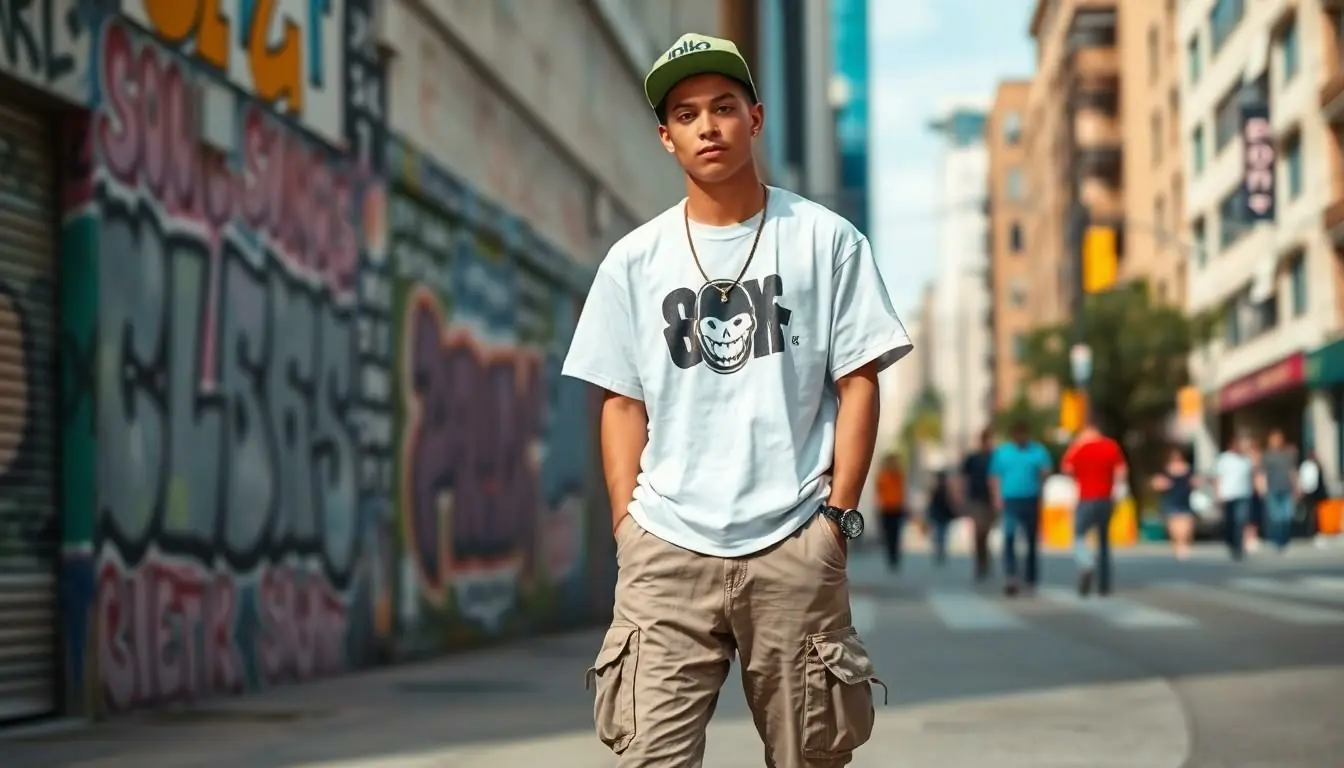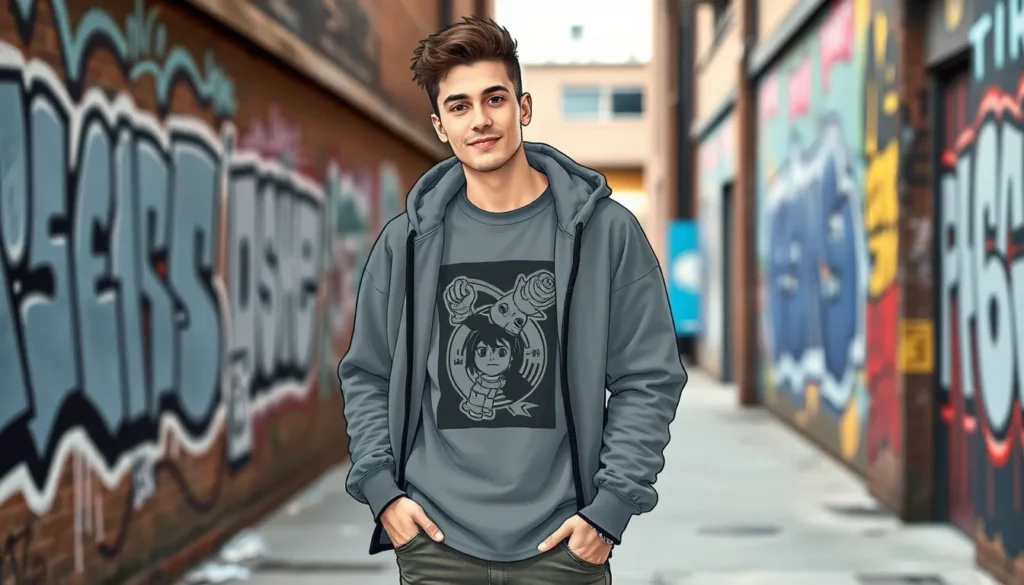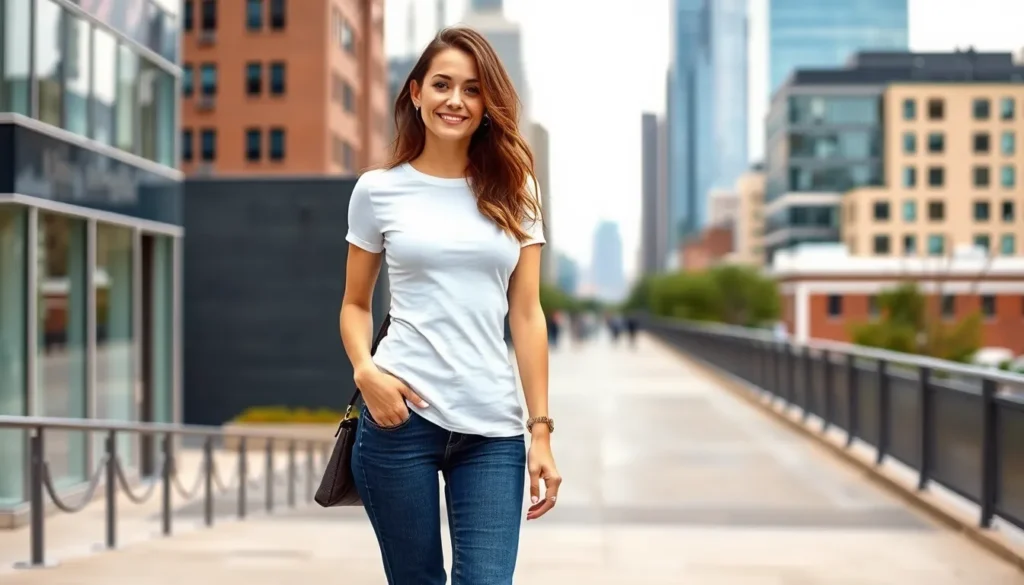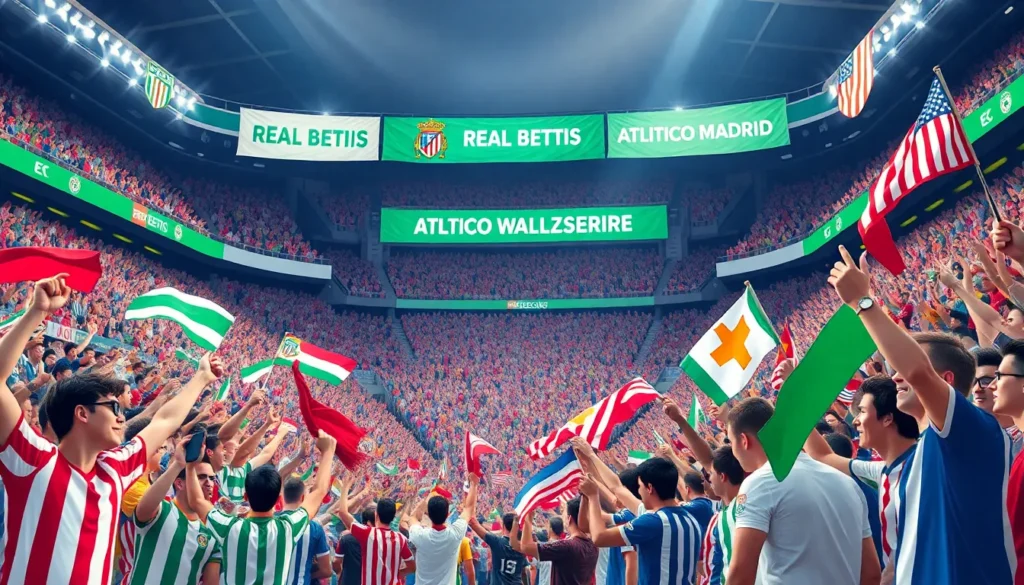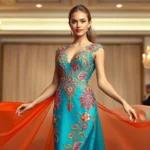Streetwear in the 2000s was like the wild west of fashion—anything went and the bolder, the better. Picture oversized tees, baggy jeans, and sneakers that could double as small boats. It was a time when logos were louder than a rock concert and style was all about making a statement, even if that statement was “I just rolled out of bed.”
This era wasn’t just about clothes; it was a cultural revolution that blended music, art, and youth rebellion. From skate parks to music festivals, men embraced a relaxed yet edgy vibe that still influences fashion today. So grab your favorite snapback and get ready to dive into the unforgettable world of 2000s streetwear, where every outfit told a story and comfort was king.
Table of Contents
ToggleOverview of Streetwear 2000’s Fashion Men
Streetwear in the 2000s represented a cultural shift that redefined men’s fashion. Designers drew inspiration from skate culture, hip-hop, and urban landscapes to create unique styles. Popular items included oversized graphic tees, cargo pants, and hoodies, reflecting a relaxed yet stylish aesthetic. Accessories such as snapback caps and statement sneakers became essential, contributing to an overall bold look.
Youth embraced this fashion as a means of self-expression, creating a connection between clothing and personal identity. Influential brands like Stüssy, Supreme, and A Bathing Ape played crucial roles in popularizing streetwear. Collaborations with artists and musicians helped to further cement streetwear’s status in mainstream fashion.
Colors and patterns were diverse, often featuring bright hues, camo prints, and unique graphics. Comfort materialized as a priority alongside style, leading to designs that allowed movement while maintaining a fashionable appearance. The layering of different textures and styles enhanced visual appeal and added depth to outfits.
Footwear became paramount in defining streetwear looks, with brands like Nike and Adidas releasing iconic sneakers that blended performance and aesthetics. Limited edition releases created a sense of exclusivity, driving a sneaker culture that persists today. Vintage styles also made a comeback, allowing men to explore fashion from previous decades while incorporating modern elements.
Notably, streetwear encouraged individuality during a time of social change and technological advancement. The internet emerged as a platform for sharing and promoting this fashion, further broadening its reach. Influencers and celebrities began to endorse streetwear, shaping trends and inspiring a new generation of fashion enthusiasts.
Key Influences on 2000’s Streetwear

Streetwear in the 2000s emerged from a rich blend of cultural elements that shaped its distinctive style.
Music and Pop Culture
Music genres like hip-hop and punk significantly influenced 2000s streetwear. Artists such as Pharrell Williams and Kanye West popularized bold fashion choices, blending musical creativity with personal style. The rise of music videos illustrated how clothing often became a visual extension of an artist’s persona. Festivals and concerts served as vital platforms for showcasing trends, while mixtapes often included collaborations between musicians and designers. Pop culture icons embraced streetwear, leading to a cultural shift where fashion statements became intertwined with musical narratives.
Celebrity Endorsements
Celebrity endorsements fundamentally transformed the perception of streetwear in the 2000s. Influential figures including Jay-Z, Lil Wayne, and Rihanna frequently donned pieces from prominent brands. Brands like Supreme and A Bathing Ape saw exponential growth after being featured by these stars. Their styles often became aspirational, prompting fans to emulate their fashion choices. The visibility of these celebrities on social media platforms amplified the reach of streetwear, creating a direct connection between fashion and everyday life. This era showcased how endorsements could establish trends, influencing sales and brand popularity immediately.
Signature Styles of 2000’s Streetwear
Streetwear in the 2000s embraced unique styles that defined an era of bold expression and individuality.
Graphic Tees and Hoodies
Graphic tees served as canvas for personal expression, showcasing vibrant prints and slogans. Brands like Supreme and Stüssy popularized these items, making them iconic staples. Hoodies, often oversized, provided comfort without sacrificing style. Layering became a common trend, and people accessorized with caps or chains to enhance their outfits. This attire resonated with the youth, connecting music and art with everyday wear. Streetwear enthusiasts eagerly sought out limited-edition drops, leading to the rise of resale culture.
Baggy Jeans and Cargo Pants
Baggy jeans captured the essence of laid-back fashion. Popular among men, these jeans featured loose fits that encouraged freedom of movement. Cargo pants gained traction due to their utility and comfort, often adorned with multiple pockets. Styles differed, from denim to khaki, appealing to diverse preferences. Combining these bottoms with oversized tops created a balanced silhouette. Popular brands such as Ecko Unltd. and Levi’s provided a range of options, cementing the styles in streetwear history. This combination of comfort and aesthetics characterized the adventurous spirit of 2000s men’s fashion.
Iconic Brands and Designers
The 2000s streetwear scene showcased distinctive brands that defined an era. Several key players emerged, leaving a lasting impact on men’s fashion.
Supreme and Stüssy
Supreme became synonymous with street culture, blending skateboarding with high-fashion aesthetics. Founded in 1994, it introduced bold graphic tees and innovative collaborations that captured the attention of youth. Stüssy, known for its laid-back surfer vibe, played a crucial role as well. Founded in the early 1980s, Stüssy combined streetwear with California cool, making its logo almost iconic. Together, these brands pushed the boundaries of fashion, influencing a generation’s clothing choices.
A Bathing Ape and Nike
A Bathing Ape, or BAPE, made waves with its vibrant camouflage patterns. Founded in 1993, this brand became a favorite among hip-hop artists and celebrities. Nike’s influence was undeniable; its sneaker collaborations shaped streetwear culture. The iconic Air Force 1 and Air Max lines saw innovative designs appealing to sneaker enthusiasts. Working together, BAPE and Nike created unique limited editions that fueled hype and desirability. These partnerships not only defined 2000s streetwear but also established a blueprint for future collaborations in the fashion industry.
Evolution and Impact on Modern Fashion
2000s streetwear laid a foundation for contemporary fashion trends. The era’s emphasis on comfort and self-expression resonates in today’s styles, which often blend casual aesthetics with high-fashion elements. Oversized silhouettes remain popular, demonstrating how this period influenced current designs.
Brands like Supreme and A Bathing Ape introduced bold graphics and unique patterns, a trend that persists in modern collections. Graphic tees and hoodies serve as focal points in both vintage and current wardrobes, showcasing personal style and individuality. Baggy jeans and cargo pants, once staples of the 2000s, continue to find favor, merging practicality with modern cuts.
Celebrity endorsements significantly shaped the perception of streetwear in the early 2000s. Icons such as Kanye West and Pharrell Williams set trends that many follow today, establishing a strong link between music culture and fashion. Their influence encouraged brands to seek collaborations with artists, a strategy that remains effective in engaging new audiences.
Footwear also evolved during this time, with sneaker culture becoming a prominent aspect of fashion. Limited-edition drops and collaborations, like those between Nike and various designers, sparked a resale market that thrives today. Sneakerheads now actively search for unique releases, reflecting the culture’s ongoing relevance.
The integration of streetwear into mainstream fashion highlights its lasting impact. Many high-end designers incorporate streetwear elements, demonstrating its broad appeal and adaptability. As styles continue to merge, the spirit of 2000s streetwear finds itself reinterpreted, ensuring its legacy endures in the ever-evolving landscape of fashion.
Conclusion
The 2000s streetwear movement left an indelible mark on men’s fashion that continues to inspire today. Its unique blend of comfort and self-expression reshaped how individuals approach style, making bold statements through clothing choices. The influence of music culture and the rise of iconic brands created a vibrant landscape where creativity thrived.
As streetwear evolves, the essence of the 2000s remains relevant, with oversized silhouettes and graphic designs still dominating wardrobes. The collaboration between fashion and music continues to flourish, ensuring that the spirit of this era lives on. Embracing individuality and comfort, the legacy of 2000s streetwear will always resonate in the ever-changing world of fashion.

